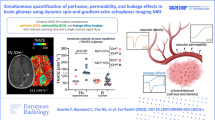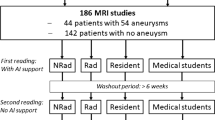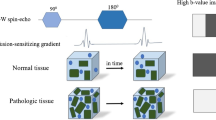Abstract
The shuttle scan technique is expected to extend scan range in cerebral computed tomography (CT) perfusion by 16- or 64-row multidetector CT (MDCT), but it may affect quantitative accuracy. This study aims to evaluate the effect of long scan interval and bolus length on the quantitative accuracy of perfusion indices using an innovative hollow-fiber phantom.We used an originally developed hollow-fiber hemodialyzer covered with polyurethane resin as a perfusion phantom. We scanned the phantom during various scan intervals (1–13 s) and bolus injection lengths (5, 10, 15, and 20 s), and evaluated cerebral blood flow (CBF), cerebral blood volume (CBV), mean transit time (MTT), and time-to-peak (TTP). We verified the influence on measured values using a two-way analysis of variance (ANOVA). All measured CBF values were smaller than the theoretical CBF values, and all the measured MTT values were larger that the theoretical MTT values (95% confidence interval). Extended scan intervals resulted in more overestimation of MTT and more underestimation of CBF (p < 0.001). CBV is not affected by the change in scan interval (p < 0.001), and a longer bolus length improved the underestimation of CBV (p < 0.001). Extended scan intervals resulted in the loss of quantitative accuracy in MTT, even with longer bolus injection length, while quantitative CBF values were underestimated and TTP values overestimated. The CBV measurement was not affected by the change in scan interval, and a longer bolus injection improved the accuracy of these measurements.



Similar content being viewed by others
Abbreviations
- AIF:
-
arterial input function
- b-SVD:
-
block-circulant singular value decomposition
- CBF:
-
cerebral blood flow
- CBV:
-
cerebral blood volume
- CTP:
-
computed tomography perfusion
- MDCT:
-
multidetector computed tomography
- MTT:
-
mean transit time
- TCC:
-
tissue contrast curve
- T max :
-
time-to-maximum
- TTP:
-
time-to-peak
References
Klotz E, König M. Perfusion measurements of the brain: using dynamic CT for the quantitative assessment of cerebral ischemia in acute stroke. Eur J Radiol. 1999;30:170–84.
Mayer TE, Hamann GF, Baranczyk J, et al. Dynamic CT perfusion imaging of acute stroke. Am J Neuroradiol. 2000;21:1441–9.
Lev MH, Segal AZ, Farkas J, Hossain ST, Putman C, Hunter GJ, et al. Utility of perfusion-weighted CT imaging in acute middle cerebral artery stroke treated with intra-arterial thrombolysis: prediction of final infarct volume and clinical outcome. Stroke. 2001;32:2021–8.
Wintermark M, Reichhart M, Thiran JP, Maeder P, Chalaron M, Schnyder P, et al. Prognostic accuracy of cerebral blood flow measurement by perfusion computed tomography, at the time of emergency room admission, in acute stroke patients. Ann Neurol. 2002;51:417–32.
Murayama K, Katada K, Nakane M, Toyama H, Anno H, Hayakawa M, et al. Whole-brain perfusion CT performed with a prototype 256–detector row CT System: initial experience. Radiology. 2002;250:202–11.
Roberts HC, Roberts TPL, Smith WS, Lee TJ, Fischbein NJ, Dillon WP. Multisection dynamic CT perfusion for acute cerebral ischemia: the “toggling-table” technique. Am J Neuroradiol. 2001;22:1077–80.
Suzuki K, Morita S, Masukawa A, Machida H, Ueno E. Utility of CT perfusion with 64-row multi-detector CT for acute ischemic brain stroke. Emerg Radiol. 2011;18:95–101.
Wintermark M, Smith WS, Ko NU, Quist M, Schnyder P, Dillon WP. Dynamic perfusion CT: optimizing the temporal resolution and contrast volume for calculation of perfusion CT parameters in stroke patients. Am J Neuroradiol. 2004;25:720–9.
Suzuki K, Hashimoto H, Okaniwa E, Iimura H, Suzaki S, Abe K, et al. Quantitative accuracy of computed tomography perfusion under low-dose conditions, measured using a hollow-fiber phantom. Jpn J Radiol. 2017;35:373–80.
Okaniwa E, Hashimoto H, Suzuki K, Iimura H, Suzaki S, Abe K, Ejima M, Sakai S. Technique and theory of hollow-fiber phantom for cerebral CT perfusion. Nihon Hoshasen Gijutsu Gakkai Zasshi. 2017;73:128–32.
Wu O, Ostergaard L, Weisskoff RM, Benner T, Rosen BR, Sorensen AG. Tracer arrival timing-insensitive technique for estimating flow in MR perfusion-weighted imaging using singular value decomposition with a block-circulant deconvolution matrix. Magn Reson Med. 2003;50:164–74.
Kudo K, Sasaki M, Yamada K, Momoshima S, Utsunomiya H, Shirato H, et al. Differences in CT perfusion maps generated by different commercial software: quantitative analysis by using identical source data of acute stroke patients. Radiology. 2010;254:200–9.
Konstas AA, Goldmakher GV, Lee TY, Lev MH. Theoretic basis and technical implementations of CT perfusion in acute ischemic stroke. Part 1. Theoretic basis. Am J Neuroradiol. 2009;30:662–8.
Meier P, Zierler KL. On the theory of the indicator-dilution method for measurement of blood flow and volume. Appl Physiol. 1954;6:731–44.
Powers WJ. Cerebral hemodynamics in ischemic cerebrovascular disease. Ann Neurol. 1991;29:231–40.
Reichenbach JR, Röther J, Jonetz-Mentzel L, Herzau M, Fiala A, Weiller C, et al. Acute stroke evaluated by time-to-peak mapping during initial and early follow-up perfusion CT studies. Am J Neuroradiol. 1999;20:1842–50.
Donnan GA, Baron JC, Ma H, Davis SM. Penumbral selection of patients for trials of acute stroke therapy. Lancet Neurol. 2009;8:261–9.
Ding B, Ling HW, Chen KM, Jiang H, Zhu YB. Comparison of cerebral blood volume and permeability in preoperative grading of intracranial glioma using CT perfusion imaging. Neuroradiology. 2006;48:773–81.
Ellika S, Jain R, Patel S, Scarpace L, Schultz LR, Rock JP, et al. Role of perfusion CT in glioma grading and comparison with conventional MR imaging features. Am J Neuroradiol. 2012;33:2038–42.
Olivot JM, Mlynash M, Thijs VN, Kemp S, Lansberg MG, Wechsler L, et al. Optimal Tmax threshold for predicting penumbral tissue in acute stroke. Stroke. 2009;40:469–75.
Calamante F, Christensen S, Desmond PM, Ostergaard L, Davis SM, Connelly A. The physiological significance of the time-to-maximum (Tmax) parameter in perfusion MRI. Stroke. 2010;41:1169–74.
Acknowledgements
This work was supported by the Japan Society for the Promotion of Science (JSPS) KAKENHI (Grants-in-Aid for Scientific Research) Grant Number 26460733.
Author information
Authors and Affiliations
Corresponding author
Ethics declarations
Conflict of interest
The authors declare that they have no conflict of interest.
Human rights
This article does not contain any studies involving human participants.
Informed consent
This article does not contain any studies involving animals.
About this article
Cite this article
Hashimoto, H., Suzuki, K., Okaniwa, E. et al. The effect of scan interval and bolus length on the quantitative accuracy of cerebral computed tomography perfusion analysis using a hollow-fiber phantom. Radiol Phys Technol 11, 13–19 (2018). https://doi.org/10.1007/s12194-017-0427-0
Received:
Revised:
Accepted:
Published:
Issue Date:
DOI: https://doi.org/10.1007/s12194-017-0427-0




